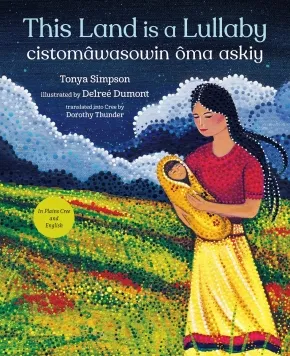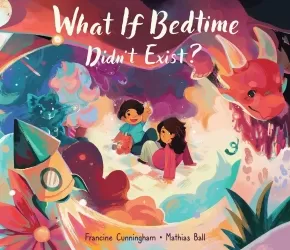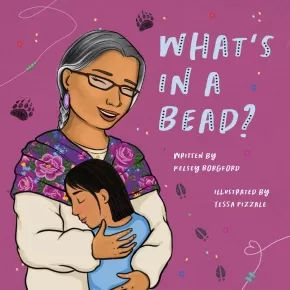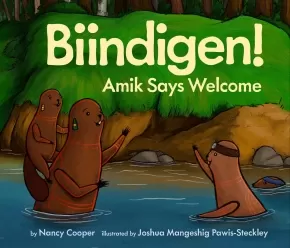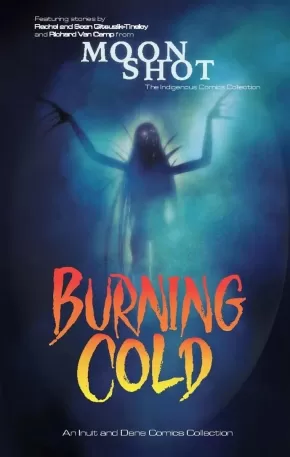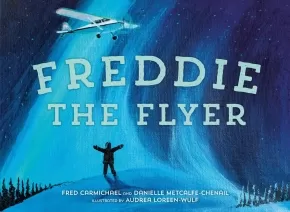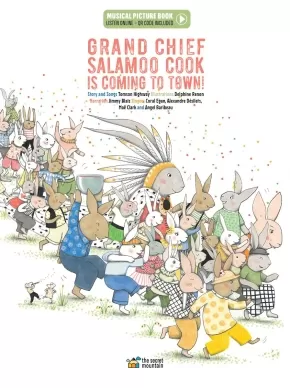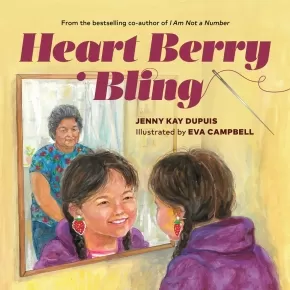
Canadian Indigenous Resource Lists
76
-
90
of
473 Results;
Sort By
Go To
of 32
This Land Is a Lullaby
$21.95
Format:
Hardcover
Text Content Territories:
Indigenous Canadian; First Nations; Cree (Nehiyawak); Plains Cree; Pasqua First Nation;
Grade Levels: Preschool; Kindergarten;
ISBN / Barcode: 9781459836099
Synopsis:
Synopsis:
It flows in your blood and echoes in your soul...Listen, my baby, to the sweet song of your home.
As daylight fades to dusk and slips into darkness, this gentle lullaby celebrates the sounds of the Prairies and the Plains on a stormy summer's night.
From the hum of dragonflies to the drumming of thunder, with grasses swirling and the northern lights glimmering, This Land Is a Lullaby shares a song and dance—a gift from the ancestors that soothes children to sleep and reminds them of their deeply rooted connections to the land.
Written as a lullaby for the author's daughter and featuring striking pointillism artwork, this lush lullaby of the land honors the beauty of the Prairies and the Plains and the spiritual connection between Indigenous children, ancestors and their Traditional Territories.
Awards
- Winner of the 2025 Governor General's Literary Award
Reviews
“The book’s lexical simplicity and visual dynamism will engage even the youngest readers, providing a beautiful glimpse into the unbreakable bond between Indigenous people, their lands, and their ancestors who are still a part of them. Like a stirring song, this tale will move readers with its tranquil, reverent tone.”- Kirkus Reviews
Educator Information
Recommended for ages 3 to 5.
Reading Levels
Fountas & Pinnell Text Level Gradient: M
Lexile measure: AD570L
Guided Reading Level: M
This book is available in a dual-language format (English and Plains Cree): This Land Is a Lullaby / cistomâwasowin ôma askiy
Additional Information
32 pages | 8.75" x 10.75" | Hardcover
This Land Is a Lullaby / cistomâwasowin ôma askiy
$21.95
Format:
Hardcover
Text Content Territories:
Indigenous Canadian; First Nations; Cree (Nehiyawak); Plains Cree; Pasqua First Nation;
Grade Levels: Preschool; Kindergarten;
ISBN / Barcode: 9781459838475
Synopsis:
Synopsis:
It flows in your blood and echoes in your soul...Listen, my baby, to the sweet song of your home.
As daylight fades to dusk and slips into darkness, this gentle lullaby celebrates the sounds of the Prairies and the Plains on a stormy summer's night.
From the hum of dragonflies to the drumming of thunder, with grasses swirling and the northern lights glimmering, This Land Is a Lullaby shares a song and dance—a gift from the ancestors that soothes children to sleep and reminds them of their deeply rooted connections to the land.
Written as a lullaby for the author's daughter and featuring striking pointillism artwork, this lush lullaby of the land honors the beauty of the Prairies and the Plains and the spiritual connection between Indigenous children, ancestors and their Traditional Territories.
This bilingual book includes full text in both English and Plains Cree.
Reviews
“The book’s lexical simplicity and visual dynamism will engage even the youngest readers, providing a beautiful glimpse into the unbreakable bond between Indigenous people, their lands, and their ancestors who are still a part of them. Like a stirring song, this tale will move readers with its tranquil, reverent tone.”- Kirkus Reviews
"Rooted in a Cree worldview, the story invites young readers to connect with the natural world around them. Through lyrical text and luminous illustrations, the story evokes a stormy summer’s night on the prairie as a gentle meditation on the land and its beings—ideal for read-alouds or quiet reflection. This picture book supports K-3 curriculum connections in English Language Arts (rhythm and rhyme), Science (sound and weather), and Arts Education (visual techniques such as pointillism)." - Bonny-Lynn D., Elementary School Teacher, Indigenous Books for Schools
Educator Information
Recommended for ages 3 to 5.
Dual Language Format: English and Plains Cree.
Reading Levels
Fountas & Pinnell Text Level Gradient: M
Lexile measure: AD570L
Guided Reading Level: M
This book is available in English: This Land Is a Lullaby
This book is included in the Indigenous Books for Schools database from the Association of Book Publishers of BC. It is recommended for K to 3 classrooms for Art, English Language Arts, Music, and Science.
Additional Information
32 pages | 8.75" x 10.75" | Hardcover
Walking Together (PB)
$12.99
Format:
Paperback
Text Content Territories:
Indigenous Canadian; First Nations; Mi'kmaq;
ISBN / Barcode: 9781773217772
Synopsis:
Synopsis:
This bestselling, innovative picture book introduces readers to the concept of Etuaptmumk—or Two-Eyed Seeing, the gift of multiple perspectives in the Mi’kmaw language—as we follow a group of young children connecting to nature as their teacher.
A poetic, joyful celebration of the Lands and Waters as spring unfolds: we watch for Robin's return, listen for Frog's croaking, and wonder at maple tree's gift of sap. Grounded in Etuaptmumk, also known as Two-Eyed Seeing—which braids together the strengths of Indigenous and non-Indigenous ways of knowing—and the Mi’kmaq concept of Netukulimk—meaning to protect Mother Earth for the ancestors, present, and future generations—Walking Together nurtures respectful, reciprocal, responsible relationships with the Land and Water, plant-life, animals and other-than-human beings for the benefit of all.
Reviews
"Walking Together is a poetic celebration grounded in Etuaptmumk (Two-Eyed Seeing) that weaves together the strengths of Indigenous and non-Indigenous ways of knowing. The story explores respectful, reciprocal, responsible relationships between the land, water, plants, animals, and humans." - The Dalai Lama Center
Educator Information
Recommended for ages 4 to 7.
Introduces the concept of Two-Eyed Seeing (the gift of multiple perspectives) to young readers.
This book is available in a bilingual format: Walking Together / Menaqaj Pemwije’tulti’k
Additional Information
36 pages | 8.90" x 8.90" | Paperback
What If Bedtime Didn't Exist?
$23.99
Artists:
Format:
Hardcover
Text Content Territories:
Indigenous;
ISBN / Barcode: 9781773218687
Synopsis:
Synopsis:
A whimsical and lyrical celebration of imagination and exploration if we simply asked, “What if . . .”
Follow two siblings through their day as they let their imaginations run wild in this joyful story about all the possibilities a simple “what if” can conjure up: What if the monsters in your closet wanted to be your friend? What if all of the dinosaurs were shrunk to be teeny-tiny when the comet hit the earth? And what if bedtime didn’t exist and we could imagine anything we wanted?
What If Bedtime Didn’t Exist? places an Urban Indigenous family at the heart of a fun and fantastical celebration of daydreaming, adventure, and play while living in the city. The tenderness and care in this intergenerational home is seen through relationships with all members in the family.
Mathias Ball’s vibrant illustrations bring each page of acclaimed author Francine Cunningham’s debut picture book to life. What If Bedtime Didn’t Exist? opens up new spaces for creativity and endless possibilities into our everyday world.
Reviews
“A tenderly written, beautifully illustrated story that taps into our creative selves. I can already hear the oohs and awes and giggles, and see little fingers circling around the drawings discovering each “what if” and imagining the imaginings. A wonderful story that’s going to kick off so many conversations between readers about all of the “what ifs!”. So much fun!” — Julie Flett, author of We All Play and Birdsong
“What if the imagination of kids created the world? Then every day would be filled with the rollicking, bright and sparkling, fantastical, astronomical adventures Francine Cunningham and Mathias Ball give us here. Sign me up!” — Caroline Adderson, author of more than twenty books for children including It Happened on Sweet Street and Norman, Speak!
“What if Bedtime Didn’t Exist? is a day dream that sings and celebrates the innocence of imagination. Every page is pure cozy magic! I want to live in this book! I love it!” — Richard Van Camp, author of What’s the Most Beautiful Thing You Know About Horses?
“Francine Cunningham has gifted us a story for readers in search of adventure in the everyday. What if Bedtime Didn’t Exist showcases Cunningham’s writing as expansive as riding with dragons and as intimate as confiding hard feels with ladybugs. For the adventurous and sensitive kid alike, What If Bedtime Didn’t Exist is guided by two Indigenous siblings with boundless curiosity, who remind us that the true source of our magic is embedded in our own imaginations.” — Whitney French, editor of Black Writers Matter
Educator Information
Recommended for ages 4 to 7.
Recommended in the Indigenous Books for Schools catalogue as a valuable resource for English Language Arts for k to 3.
Themes: Childhood, Family.
Additional Information
36 pages | 10.00" x 8.50" | Hardcover
What's in a Bead?
$21.95
Artists:
Text Content Territories:
Indigenous Canadian; First Nations; Anishinaabeg; Cree (Nehiyawak);
ISBN / Barcode: 9781772603668
Synopsis:
Synopsis:
There are many stories in a bead. We must listen to the stories they tell us.
Tessa loves how her grandmother always smells of campfire stories. Mom says it’s because Kohkom spends her days sewing beautiful beads onto smoked hides. Inspired, Tessa asks Kohkom to teach her beading, but first she must listen and learn about the many stories held in a bead.
A celebration of Cree craftsmanship, language, and learning. The loving exchange of knowledge between Tessa and her Kohkom will be familiar to many children. Readers will learn that different Indigenous communities have different beadwork techniques, and that this traditional art form is alive and thriving today.
Reviews
"The story is a beautiful look into the importance of beading in our communities and the ways that this art practice ties us together as families and communities." — Nancy Cooper, First Nations Consultant for the Southern Ontario Library Services and coordinator for First Nation Communities Read
"Borgford demonstrates within this book the way Story is a very useful and meaningful method of passing on and sharing Indigenous Knowledge. Interwoven within the story are Cree words. The illustrator uses bright pictures that add additional cultural meaning and bring to life the smells and tactile learnings within the story." - Meredith R., Elementary School Teacher, Indigenous Books for Schools
Educator Information
Recommended for ages 6 to 8.
A dual-language version in Ininîmowin (Cree, N-dialect) and English is available: kekwan etakwak mîkisîhk / What’s in a Bead?
This book is available in French: Le pouvoir d'une perle.
This book is included in the Indigenous Books for Schools database from the Association of Book Publishers of BC. It is recommended for K to 3 classrooms for Art, English Language Arts, and Social Studies.
Additional Information
24 pages | 8.50" x 8.50" | Hardcover
When I Visit Qikiqtarjuaq
$16.95
Artists:
Format:
Paperback
Text Content Territories:
Indigenous Canadian; Inuit;
Grade Levels: Preschool; Kindergarten;
ISBN / Barcode: 9781774508053
Synopsis:
Synopsis:
"There are many things I would like to do and see with my friend in Qikiqtarjuaq."
Monica wants to visit her friend Mary in Qikiqtarjuaq, Nunavut. Monica likes to imagine all the fun they will have together there. Monica and Mary will go camping, fish for delicious Arctic char, and see the big icebergs around the community. There will be lots to do when Monica visits Qikiqtarjuaq in this bilingual picture book!
Reviews
"The book touches on Qikiqtarjuaq’s history while highlighting the natural features and landforms that define the region, known as the “iceberg capital” of Nunavut. Through simple, descriptive language and vivid illustrations, it offers a warm, culturally rich introduction to Arctic life, Inuit clothing and Traditions, and the northern landscape. Ideal for early primary classrooms, this story invites students to explore place-based experiences, family, belonging, and a deep connection to community and land." - Shannon D., Elementary & Middle School Teacher, Indigenous Books for Schools
Educator & Series Information
Recommended for ages 3 to 5.
Dual-Language: English and Inuktitut.
This book is part of the Community Connections series.
This book is included in the Indigenous Books for Schools database from the Association of Book Publishers of BC. It is recommended for K to 2 classrooms for English Language Arts, Science, Social Studies.
Additional Information
19 pages | 8.00" x 9.00" | Paperback
You Are the Land
 $18.95
$18.95

Artists:
Format:
Hardcover
Text Content Territories:
Indigenous Canadian; First Nations; Anishinaabeg;
ISBN / Barcode: 9781771746328
Synopsis:
Synopsis:
Inspired by the Physical quadrant of the Anishinaabe Medicine Wheel, You Are the Land reminds young readers that they are a part of the world around them. With fun, rhyming text, each page compares our physical bodies to plants, animals, and the four elements, sharing an important message: You are the Land.
From the author of You Are Sacred, this is the second book in the All That You Are series.
Awards
- 2025-2026 First Nation Communities READ Award Longlisted
Reviews
"This warm, inviting book supports BC’s Core Competencies by helping children build self-awareness, a positive sense of identity, and care for the land and one another. Its key message—that we are the land—reminds young readers they are deeply connected to and share responsibility for the natural world. It’s a thoughtful resource for early K-2 classrooms." – Shannon D., elementary and middle school teacher, Indigenous Books for Schools
Educator Information
You Are the Land is a perfect read-aloud for children ages 3 to 6 in both classrooms and homes.
Curriculum Connections:
Early Literacy – listening, reading, discussing, and rhyming
Art – traditional Anishinaabe clothing and art
Health and Wellness – breath and balance, self-affirmation, connection to nature for physical health and wellness, and traditional medicines
Science – harmonious ecosystems, biodiversity of plants and animals with Indigenous cultural importance, environmental awareness
Social Responsibility – uplifting others and ourselves, respecting Mother Earth
Indigenous Knowledge and Traditions – teachings of the Anishinaabe Medicine Wheel, the Seven Generations, the Three Sisters, and All Our Relations
This book is included in the Indigenous Books for Schools database from the Association of Book Publishers of BC. It is recommended for K to 2 classrooms for English Language Arts, Physical and Health Education, Science, and Social Studies.
Series Information
You Are the Land is the second book in the All That You Are series. Through lyrical text and colourful watercolour illustrations, the All That You Are series uses the teachings of the Anishinaabe Medicine Wheel to remind children of their connection to the world around them. Each book in the series focuses on one quadrant of the Medicine Wheel representing one kind of wellness—Spiritual, Physical, Emotional, or Mental. A diagram and description of the Medicine Wheel are included at the back of each book. Also included are Anishinaabe Connections, which share more about Anishinaabe art, culture, and traditions explored in the text and illustrations. Books in the All That You Are series are best suited for children ages 3 to 6 and make wonderful read-alouds in classrooms and homes.
You Are Sacred is the first book in the series.
A percentage of proceeds from the All That You Are series is donated to the Indian Residential School Survivors Society to support their efforts in advocacy for justice and healing. To find out more information, please visit https://www.irsss.ca/.
Additional Information
24 Pages | 8" x 8" | Hardcover | ISBN: 978-1-77174-632-8
Beautiful Beautiful: A Novel
$24.95
Format:
Paperback
Text Content Territories:
Indigenous Canadian; First Nations; Heiltsuk (Bella Bella);
Reading Level: N/A
ISBN / Barcode: 9780889714540
Synopsis:
Synopsis:
Imbued with passion, creativity and insight, Brandon Reid’s debut novel is a wonderfully creative coming-of-age story exploring indigeneity, masculinity and cultural tradition.
Twelve-year-old Derik Mormin travels with his father and a family friend to Bella Bella for his grandfather’s funeral. Along the way, he uncovers the traumatic history of his ancestors, considers his relationship to masculinity and explores the contrast between rural and urban lifestyles in hopes of reconciling the seemingly unreconcilable, the beauty of each the Indigenous and “Western” way of life—hence beautiful beautiful.
He travails a storm, meets long-lost relatives, discovers his ancestral homeland; he suffers through catching fish, gains and loses companions, learns to heal trauma. In Beautiful Beautiful we delve into the mind of a gifted boy who struggles to find his role and persona through elusive circumstance, and—
All right, that’s quite enough third-person pandering; you’re not fooling anyone. Redbird here, Derik’s babysitter, and narrator of this here story. Make sure to smash that like button. We’re here to bring light to an otherwise grave subject, friends. It’s only natural to laugh while crying. I bring story to life. One minute I’m a songbird singing from a bough, the next, I’m rapture. I connect you to the realm of spirit… Well, as best I can, given your mundane allocation.
Follow us through primordial visions, dance with a cannibal (don’t worry, they’re friendly once tamed) and discover what it takes to be united. Together, we’ll have fun. Together, we are one. So tuck in, and believe what you’ll believe, for who knows what yesterday brings. Amen and all my relations, all my relations and amen.
Reviews
“Beautiful Beautiful is a fitting title for Brandon Reid's novel, for it describes the work itself—it's simply beautiful. Reid manages to capture hypnotic traditional storytelling in written form—by stretching, manipulating and breaking traditional rules and conventions of the English language. Reid draws us into the tormentous but stunning world of a boy who, while young in years, is an ancient soul. Through brilliant description, mind-blowing shifting of perspective and a brilliant use of the boy's internal voice, we join the daily toils of a Heiltsuk family as they struggle to live off the capricious bounty of the Pacific Ocean. Like Omar El Akkad’s What Strange Paradise, Beautiful Beautiful stakes out new ground in the literary scene.”— Darrel J. McLeod, author of A Season in Chezgh’un
"Beautiful, Beautiful by Brandon Reid is a poignant middle-grade novel that follows 12-year-old Derik Mormin on a transformative journey to Bella Bella for his grandfather's funeral. Set against the backdrop of the remote coastal community, the novel explores Derik’s emotional growth as he grapples with grief, family bonds, and his Indigenous heritage. Reid sensitively portrays Derik’s internal struggles and his evolving understanding of loss and cultural identity. The book offers rich themes suitable for curriculum integration, particularly in Language Arts where students can analyze character development, narrative structure, and themes of resilience and belonging. It also provides insights into Indigenous cultures and Traditions, making it relevant for social studies discussions on community dynamics and cross-cultural studies. Additionally, Beautiful, Beautiful serves as a valuable resource for discussions on mental health and coping strategies, aligning with health and well-being curriculum goals. Overall, Reid’s novel resonates with its exploration of universal themes through the eyes of a young protagonist navigating profound personal and cultural challenges." - David D., Indigenous Educator & Administrator, Indigenous Books for Schools
Educator Information
This book is included in the Indigenous Books for Schools database from the Association of Book Publishers of BC. It is recommended for Grade 3 to 6 classrooms for English Language Arts and Social Studies.
Additional Information
336 pages | 5.50" x 8.50" | Paperback
Biindigen! Amik Says Welcome
$21.95
Format:
Hardcover
Text Content Territories:
Indigenous Canadian; First Nations; Anishinaabeg; Algonquin; Cree (Nehiyawak); Haudenosaunee (Iroquois); Kanyen'keha:ka (Mohawk); Mi'kmaq; Salish; Coast Salish; Inuit;
ISBN / Barcode: 9781771475150
Synopsis:
Synopsis:
Busy beavers have a family reunion in this story that celebrates Indigenous perspectives.
It’s a special day for Amik the beaver and her little sister, Nishiime. Their cousins are coming to visit! Amik is excited, but Nishiime feels nervous about meeting new people, and when the cousins finally arrive, Nishiime disappears.
Lively, immersive illustrations show Amik and her cousins as they search the woods for Nishiime. Each creature they encounter, introduced to readers using their Anishinaabe names, reveals how beavers help the forest community. A fish thanks them for digging canals in the mud that they swim through. A deer thanks the beavers for cutting down trees so they can reach the tastiest leaves. None of the creatures have seen Nishiime, but keen-eyed kids will have spotted her hiding in the background throughout the story.
Eventually, Nishiime returns to the group, having overcome her shyness by learning an important lesson: despite being from different places, the beavers are all united by the ways they support the forest ecosystem. With the perfect blend of fact and fun, this salute to the industrious beaver is also an energetic celebration of Indigenous perspectives, languages, and diversity.
Educator Information
Recommended for ages 3 to 7.
Includes some Anishinaabe words. A glossary is found at the back of the book.
Each beaver in the story comes from a different Nation, and their names mean "beaver" in their own language.
Curriculum Connections
Language Arts: Reading
Science: Needs and Characteristics of Living Things; Habitats
Social Studies: Indigenous Peoples
Additional Information
32 pages | 10.50" x 9.00" | Hardcover
Burning Cold: An Inuit and Dene Comics Collection
$19.95
Format:
Paperback
Text Content Territories:
Indigenous Canadian; First Nations; Dene; Inuit;
ISBN / Barcode: 9781774506547
Synopsis:
Synopsis:
Journey to the depths of the Arctic and beyond in this unique collection of stories from the award-winning volumes of Moonshot: The Indigenous Comics Collection.
Burning Cold is a captivating volume of Indigenous graphic stories written by acclaimed authors Sean and Rachel Qitsualik-Tinsley and Richard Van Camp. Time travel on the back of a wolverine, swim with shapeshifters beneath the ice, and travel through the skies with aliens. From traditional stories to reimagined futures, this collection showcases some of the finest comic book and graphic novel work from the North.
Reviews
"Burning Cold is a captivating collection of First Nations and Inuit stories by Sean and Rachel Qitsualik-Tinsley and Richard Van Camp. Each author brings a unique storytelling style, offering a diverse mix of fantasy, horror, science fiction, and Traditional Stories. Rooted in oral Traditions, the stories feature traditional characters and narratives, reimagined across various settings and times. These tales evoke a haunting atmosphere, exploring themes such as death, generosity, aliens, forgiveness, and cultural activities. The collection includes graphic cartoons and short stories. Due to sensitive content, such as mentions of deceased infants, each story should be considered individually. While some stories can be used with grade 6 students, this entire book is not recommended for students below grade 9 without guidance." - Jackie L., Educator & Indigenous Voice Consultant, Indigenous Books for Schools
Educator Information
Recommended for Young Adults.
This book is included in the Indigenous Books for Schools database from the Association of Book Publishers of BC. It is recommended for Grades 6 to 12 for English Language Arts.
Caution: As noted in the Indigenous Books for Schools database, "Due to sensitive content, such as mentions of deceased infants, each story should be considered individually. While some stories can be used with grade 6 students, this entire book is not recommended for students below grade 9 without guidance."
Additional Information
100 pages | 6.50" x 10.25" | Colour Illustrations | Paperback
Freddie the Flyer
$23.99
Artists:
Format:
Hardcover
Text Content Territories:
Indigenous Canadian; First Nations; Dene; Dinjii Zhuh (Gwich'in);
ISBN / Barcode: 9781774880807
Synopsis:
Synopsis:
A gorgeous picture book that pays homage to aviator Freddie Carmichael — the first Indigenous commercial pilot in the Arctic —with each month of the year highlighting moments from his life, the beauty of the North and the power of dreams.
When Freddie was young, he saw a plane up close for the first time when it dropped off supplies at his family’s remote bush camp. He was instantly hooked.
Freddie has flown for nearly seventy years, doing everything from supply runs to search and rescue to transporting dog teams to far-flung areas.
This book celebrates Freddie’s early dreams of flying and his later achievements. Readers move with Freddie through the year, hearing about his journey as a pilot and leader, while learning the names of the months in Gwich’in and Inuvialuktun at the same time. Art from Inuvialuit painter Audrea Loreen-Wulf perfectly captures the incredible Western Arctic as well as Freddie’s love for aviation.
Reviews
"The story of an Indigenous boy who dreamed of taking to the sky unfolds across the year in this picture-book biography that draws on Gwich’in language, the power of an unshakable passion, and, as rendered in the gorgeous painted illustrations, the beauty of nature." —Booklist
Educator Information
Recommended for ages 3 to 7.
Additional Information
32 pages | 11.31" x 8.25" | Hardcover
Grand Chief Salamoo Cook is Coming to Town!
$19.95
Artists:
Format:
Hardcover
Text Content Territories:
Indigenous Canadian; First Nations; Cree (Nehiyawak);
ISBN / Barcode: 9782898360428
Synopsis:
Synopsis:
Once upon a magical time, a young rabbit named Weeskits hurried home to Kisoos—a town known as the Earth’s belly button—to deliver some thrilling news. Salamoo Cook, the Grand Chief of all rabbits in the world, was on his way to announce a mysterious contest. The prize? A year’s supply of all-healing waaskeechoos juice, fresh from spruce cones that have just fallen. Would Weeskits be able to help his brother Keegach win the juice to rid his wife of the dreadful manchoos?
Grand Chief Salamoo Cook is Coming to Town! is a laugh-out-loud riot of a tale in English, interspersed with nine jazzy songs performed in Cree.
This musical picture book includes a QR code to access the narrated story and songs online and a glossary of Cree words used throughout the tale.
Educator Information
Recommended for grades 2 and 3.
This musical picture book includes a QR code to access the narrated story and songs online and a glossary of Cree words used throughout the tale.
Themes / Subjects: Music, Friendship, Nature, Cree.
This book is available in French: Le grand chef Salamoo Cook arrive en ville !
Additional Information
48 pages | 8.10" x 10.70" | Hardcover
Heart Berry Bling
$24.95
Artists:
Format:
Hardcover
Text Content Territories:
Indigenous Canadian; First Nations; Anishinaabeg;
ISBN / Barcode: 9781774920558
Synopsis:
Synopsis:
On a visit to her granny, Maggie is excited to begin her first-ever beading project: a pair of strawberry earrings. However, beading is much harder than she expected! As they work side by side, Granny shares how beading helped her persevere and stay connected to her Anishinaabe culture when she lost her Indian status, forcing her out of her home community—all because she married someone without status, something the men of her community could do freely.
As she learns about patience and perseverance from her granny’s teachings, Maggie discovers that beading is a journey, and like every journey, it’s easier with a loved one at her side.
In this beautifully illustrated book, children learn about the tradition of Anishinaabe beadwork, strawberry teachings, and gender discrimination in the Indian Act.
Reviews
"Social justice messages lie at the heart of many children’s and YA books with Indigenous authorship. The picture book Heart Berry Bling, written by Jenny Kay Dupuis, a member of the Nipissing First Nation, and illustrated by Ghana-born artist Eva Campbell, shares the tradition of Anishinaabe beadwork and highlights the experiences of women, including the author’s grandmother, who lost their First Nations status due to Canada’s Indian Act."— Publishers Weekly
"A delightful story."— Anishnabek News
"Heart Berry Bling is a soulful children’s story that reminds readers of not only the importance of family and culture, but also the generational harm caused by laws against Indigenous Peoples. In this tale of a young Anishinaabe girl who finds out how her own family was negatively impacted by the Indian Act, Jenny Kay Dupuis has created an important text for anyone learning of the erased ancestral stories from and about Indigenous Peoples." — John P. Broome, Purdue University
Educator Information
Recommended for ages 6 to 8.
Additional Information
48 pages | 9.00" x 9.00" | Hardcover
I Am A Rock
$22.95
Artists:
Format:
Hardcover
Text Content Territories:
Indigenous Canadian; Inuit;
Grade Levels: Preschool; Kindergarten;
ISBN / Barcode: 9781772274752
Synopsis:
Synopsis:
Pauloosie loves his pet rock, Miki Rock. Pauloosie’s Anaana, his mother, tells him a bedtime story about what Miki Rock sees, hears, and feels in his Arctic home. As part of the land, Miki Rock sees char and beluga, listens to chirps and howls, and feels the snow and sun.
Through lyrical text and ethereal landscape illustrations by Pelin Turgut, readers are taken on an Arctic journey from the point of view of a most unlikely object—a child’s pet rock.
Educator Information
Recommended for ages 3 to 5.
Recommended in the Indigenous Books for Schools catalogue as a valuable resource for English Language Arts and Science for K to 2.
Themes: Animals, Land, Respect, Arctic, Connection to Nature
Additional Information
28 pages | 9.00" x 9.50" | Hardcover
Mangilaluk: A Graphic Memoir about Friendship, Perseverance, and Resiliency
$18.95
Artists:
Format:
Paperback
Text Content Territories:
Indigenous Canadian; Inuit;
ISBN / Barcode: 9781774507384
Synopsis:
Synopsis:
“Some children are born into the world and are home as soon as they come Earthside. Others spend their lifetimes searching for a home, a place to belong, a place where they are safe. I am one of those children.”
After running away from residential school, Bernard Andreason and his two best friends begin a harrowing 130-kilometre journey from Inuvik to Tuktoyaktuk, one which only Bernard would survive. In this heartbreaking and beautifully told graphic memoir, Bernard recounts his time in residential school and the tragic journey that took the lives of his two best friends. We then follow Bernard as he returns home, haunted by his past and struggling to find his place. Despite enduring more challenges into adulthood, Bernard never stops pursuing healing and higher learning, and he finds a support network that helps him. His story shows us that the possibility of finding a safe and loving home exists, and it is something every child deserves.
Mangilaluk is an extraordinarily affecting new addition to Qinuisaarniq ("resiliency"), a collection of books created to educate readers about the history and impacts of residential schools.
Reviews
"Mangilaluk by Bernard Anderson is a middle-grade novel that immerses readers in the life of an Inuk boy named Mangilaluk, set against the backdrop of the Arctic. This coming-of-age tale explores themes of cultural identity, survival, and the clash between tradition and modern influences. In social studies and history, students can delve into the rich portrayal of Inuit culture, traditions, and the challenges faced by indigenous communities in the Arctic. In Science/Language Arts classes, the book offers insights into Arctic ecosystems, wildlife, and survival skills, making it valuable for science classes. Overall, Mangilaluk enriches education with its engaging narrative and educational connections across various disciplines, providing students a deeper understanding of Arctic life and cultural diversity." - David D., Indigenous Educator & Administrator, Indigenous Books for Schools
Educator Information
Recommended for ages 14-18 by the publisher. In the Indigenous Books for Schools database, it is recommended as a middle-grade work.
Mangilaluk exposes readers to the experience and perspective of an Inuk residential school survivor. It also shares a powerful story of friendship, personal growth and self-forgiveness, and the value of finding a supportive community.
This book is part of the Qinuisaarniq program. Qinuisaarniq (“resiliency”) is a program created to educate Nunavummiut and all Canadians about the history and impacts of residential schools, policies of assimilation, and other colonial acts that have affected the Canadian Arctic.
Each resource has been carefully written and reviewed to include level-appropriate opportunities for students to learn about colonial acts and policies that have affected Inuit. These acts and policies created long-lasting impacts on Inuit individuals and communities, which are still being felt today.
This book is included in the Indigenous Books for Schools database from the Association of Book Publishers of BC. It is recommended for Grades 5 to 8 for English Language Arts, Science, and Social Studies.
Caution: Residential school, abuse, drugs, and alcohol
Additional Information
100 pages | 7.25" x 11.00" | Paperback
Sort By
Go To
of 32




